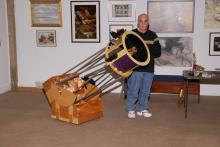Feed aggregator
Deposits found on a nearby asteroid point to salty water in the outer Solar System
Asteroids that orbit close to the Earth inevitably cause us some anxiety due to the even remote possibility of a collision. But their proximity also offers ample opportunities to learn more about the universe. Ryugu, a 900-meter diameter asteroid in the Apollo belt, has recently proven useful in our search for signs of life's precursors elsewhere in our Solar System. A team of researchers has found evidence of salt minerals in samples recovered from Ryugu during the initial phase of Japan's Hayabusa2 mission.
New research sheds light on using multiple CubeSats for in-space servicing and repair missions
As more satellites, telescopes, and other spacecraft are built to be repairable, it will take reliable trajectories for service spacecraft to reach them safely. Researchers are developing a methodology that will allow multiple CubeSats to act as servicing agents to assemble or repair a space telescope. Their method minimizes fuel consumption, guarantees that servicing agents never come closer to each other than 5 meters, and can be used to solve pathway guidance problems that aren't space related.
Phoenix galaxy cluster in the act of extreme cooling
New findings explain the Phoenix cluster's mysterious starburst. Data confirm the cluster is actively cooling and able to generate a huge amount of stellar fuel on its own.
Creation of black holes without singularities through pure gravity
Traditional black holes, as predicted by Albert Einstein's theory of General Relativity, contain what are known as singularities, i.e. points where the laws of physics break down. Identifying how singularities are resolved in the context of quantum gravity is one of the fundamental problems in theoretical physics. Now, a team of experts has described the creation of regular black holes from gravitational effects and without the need for the existence of exotic matter required by some previous models.
Astronomers gauge livability of exoplanets orbiting white dwarf stars
Astronomers used a 3D global computer model to compare the climates of exoplanets in different stellar and orbital configurations. They found that a planet orbiting a white dwarf star would offer a warmer climate than one orbiting a main sequence star.
Tidal energy measurements help scientists understand Titan's composition, orbital history
Scientists are studying Saturn's moon Titan to assess its tidal dissipation rate, the energy lost as it orbits the ringed planet with its massive gravitational force. Understanding tidal dissipation helps scientists infer many other things about Titan, such as the makeup of its inner core and its orbital history.
Euclid discovers a stunning Einstein ring
Euclid, the European Space Agency's dark Universe detective, has made an astonishing discovery -- right in our cosmic backyard.
Temperamental stars are distorting our view of distant planets
'Temperamental' stars that brighten and dim over a matter of hours or days may be distorting our view of thousands of distant planets, suggests a new study.












